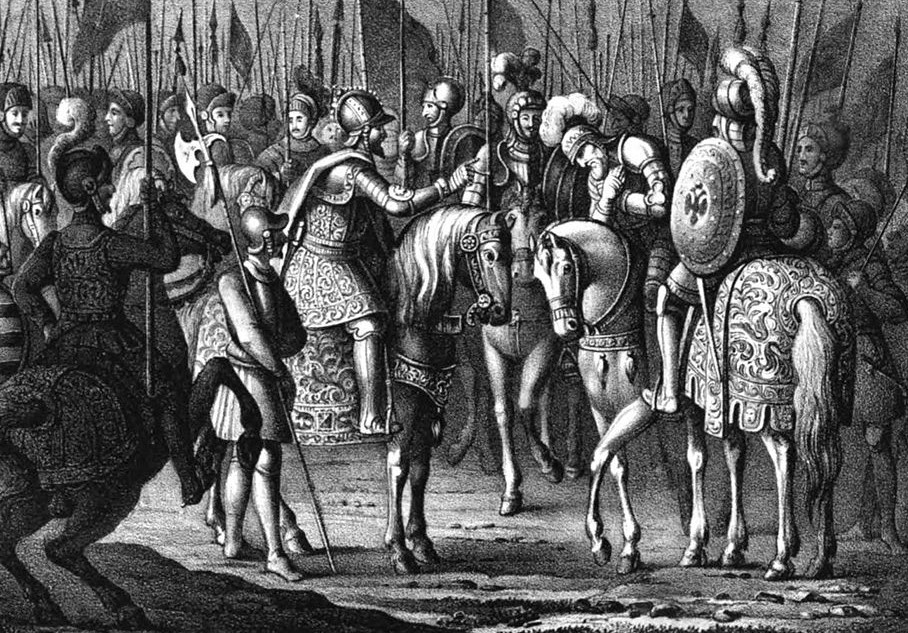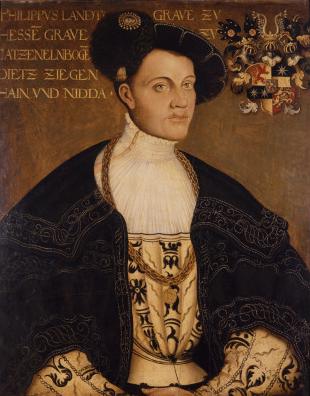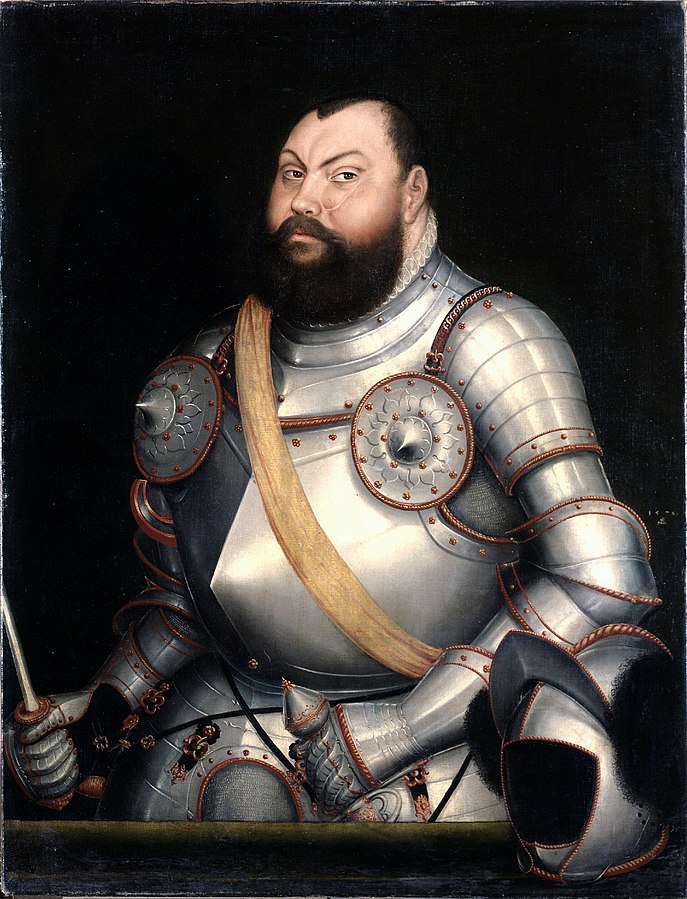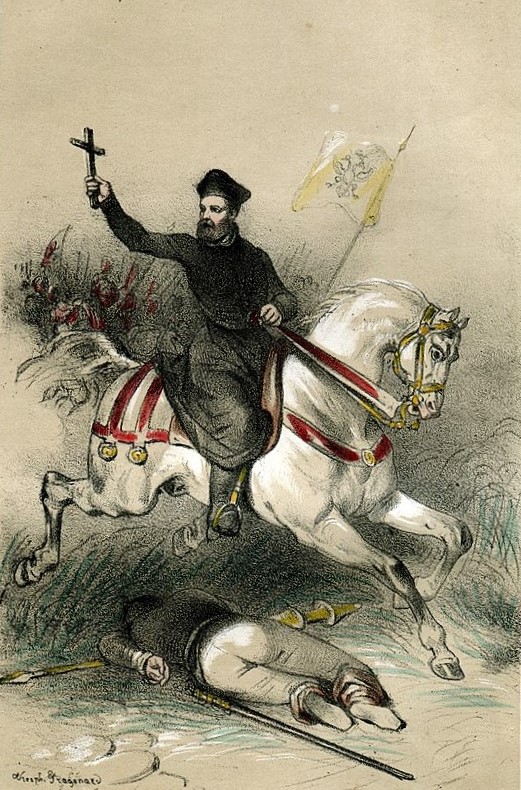
Battle of Mühlberg 1547 and imprisonment of elector Johann Friedrich of Saxony. The pictorial report focuses on the end of the Battle of Mühlberg and the capture of the elector. On the right scenes from the five-year captivity are shown.
The Battle of Mühlberg took place near Mühlberg in the Electorate of Saxony in 1547, during the Schmalkaldic War. The Catholic princes of the Holy Roman Empire led by the Holy Roman Emperor Charles V decisively defeated the Lutheran Schmalkaldic League of Protestant princes under the command of Elector John Frederick I of Saxony and Landgrave Philip I of Hesse.
The battle ended the Schmalkaldic war and led to the dissolution of the Schmalkaldic League.
What was the Schmalkaldic League?
A politico-religious alliance formally concluded on 27 Feb., 1531, at Smalkalden in Hesse-Nassau, among German Protestant princes and cities for their mutual defence. The compact was entered into for six years, and stipulated that any military attack made upon any one of the confederates on account of religion or under any other pretext was to be considered as directed against them all and resisted in common. The parties to it were: the Landgrave Philip of Hesse; the Elector John of Saxony and his son John Frederick; the dukes Philip of Brunswick-Grubenhagen and Otto, Ernest, and Francis of Brunswick-Lünenburg; Prince Wolfgang of Anhalt; the counts Gebhard and Albrecht of Mansfeld and the towns of Strasburg, Ulm, Constance, Reutlingen, Memmingen, Lindau, Biberach, Isny, Magdeburg, and Bremen. The city of Lübeck joined the league on 3 May, and Bavaria on 24 Oct., 1531. The accession of foreign powers, notably England and France, was solicited, and the alliance of the latter nation secured in 1532. The princes of Saxony and Hesse were appointed military commanders of the confederation, and its military strength fixed at 10,000 infantry and 2000 cavalry. At a meeting held at Smalkalden in Dec., 1535, the alliance was renewed for ten years, and the maintenance of the former military strength decreed, with the stipulation that it should be doubled in case of emergency. In April, 1536, Dukes Ulrich of Würtemberg and Barnim and Philip of Pomerania, the cities of Frankfort, Augsburg, Hamburg, and Hanover joined the league with several other new confederates. An alliance was concluded with Denmark in 1538, while the usual accession of the German Estates which accepted the Reformation continued to strengthen the organization. Confident of its support, the Protestant princes introduced the new religion in numerous districts, suppressed bishoprics, confiscated church property, resisted imperial ordinances to the extent of refusing help against the Turks, and disregarded the decisions of the Imperial Court of Justice.
In self-defence against the treasonable machinations of the confederation, a Catholic League was formed in 1538 at Nuremberg under the leadership of the emperor. Both sides now actively prepared for an armed conflict, which seemed imminent. But negotiations carried on at the Diet of Frankfort in 1539 resulted, partly owing to the illness of the Landgrave of Hesse, in the patching up of a temporary peace. The emperor during this respite renewed his earnest but fruitless efforts to effect a religious settlement, while the Smalkaldic confederates continued their violent proceedings against the Catholics, particularly in the territory of Brunswick-Wolfenbüttel, where Duke Henry was unjustly expelled, and the new religion introduced (1542). It became more and more evident as time went on that a conflict was unavoidable. When, in 1546, the emperor adopted stern measures against some of the confederates, the War of Smalkalden ensued. Although it was mainly a religious conflict between Catholics and Protestants, the denominational lines were not sharply drawn. With Pope Paul III, who promised financial and military assistance, several Protestant princes, the principal among whom was Duke Marice of Saxony, defended the imperial and Catholic cause. The beginning of hostilities was marked nevertheless by the success of the Smalkaldic allies; but division and irresoluteness soon weakened them and caused their ruin in Southern Germany, where princes and cities submitted in rapid succession. The battle of Mühlberg (24 April, 1547) decided the issue in favour of the emperor in the north. The Elector John Frederick of Saxony was captured, and shortly after the Landgrave Philip of Hesse was also forced to submit. The conditions of peace included the transfer of the electoral dignity from the former to his cousin Maurice, the reinstatement of Duke Henry of Wolfenbüttel in his dominions, the restoration of Bishop Julius von Pflug to his See of Naumburg-Zeitz, and a promise demanded of the vanquished to recognize and attend the Council of Trent. The dissolution of the Smalkaldic League followed; the imperial success was complete, but temporary.
The Battle
Charles was suffering from gout at that time and his army had to face the desertion of the Papal soldiers that had helped him in the first part of the campaign. In addition the Saxon Elector’s army was larger than Charles’ forces. However, hoping to encourage a Protestant and anti-imperial uprising in Bohemia, John Frederick took the decision to split his forces and he deployed a large portion of his troops there.
He had also left some small detachments to protect the most vulnerable Saxon cities in order to prevent the entry of Charles’ army from the south. With the intention of reaching the well-defended stronghold of Wittenberg, the Elector then marched northwards, abandoning his position in Meissen and camping at the end of April at the town of Mühlberg, leaving only a few troops as guards on the bank of the Elbe river, that he considered too wide to be easily crossed by the imperial forces.
At the head of his army, Charles V arrived at the Elbe on the evening of 23 April. Despite the contrary opinion of his generals, he decided to attack the enemy forces, resting just a few miles away. At dawn on 24 April the first avant-gardes of the imperial army advanced, looking for a way for all the army to cross the river. Helped by the surprise and by the dense fog that had risen from the river, small groups of Spanish and Italian veteran soldiers managed to swim across the river and eliminate the few Saxon troops that were guarding the other side.
Meanwhile, some troops of the tercios of Lombardy and Naples, that were the most experienced soldiers in Charles’ army, followed a plan set by Don Fernando Álvarez de Toledo, Duke of Alba and commander-in-chief of the Imperial troops in Germany and with the help of a local farmer, they managed to spot a ford to use that would allow all the army to cross the Elbe. In addition to this, some veteran soldiers were able to prevent the demolition of a pontoon bridge built by the Saxons, that was immediately used by the Imperial cavalry to pass safely to the other shore.
 According to some sources John Frederick had considered an attack from Charles so unlikely that he would have ordered several commanders of his army to go to Mass just when the enemy army was about to complete the crossing of the Elbe. The Saxon forces were completely taken by surprise. As soon as he became aware of the fact, the Elector’s first thought was to retreat towards Wittenberg. He soon realized though that his army would be too slow to be prepared to march in a short while; moreover, he was convinced that only a vanguard of the main imperial army was attacking. So he ordered his troops to prepare for battle.
According to some sources John Frederick had considered an attack from Charles so unlikely that he would have ordered several commanders of his army to go to Mass just when the enemy army was about to complete the crossing of the Elbe. The Saxon forces were completely taken by surprise. As soon as he became aware of the fact, the Elector’s first thought was to retreat towards Wittenberg. He soon realized though that his army would be too slow to be prepared to march in a short while; moreover, he was convinced that only a vanguard of the main imperial army was attacking. So he ordered his troops to prepare for battle.
John Frederick chose to deploy his troops along the edge of a forest, in order to prevent a possible encirclement by the imperial cavalry and to have a safer escape route in case of retreat. The emperor Charles V also reached the battlefield and exhorted his troops to fight the Protestants. Due to gout, he was carried to the battle in a litter, rather than mounted in armour on the great warhorse as depicted by his court painter, Titian and assisted to the battle from the rear. The imperial army was made up of about 16-20,000 men. Among them there were the tercios of Lombardy, Naples, and Hungary, led by Álvaro de Sande.
The battle began in the evening; the Saxon army, mainly made up of peasants, succeeded in repelling the first assaults of the Hungarian cavalry, but the greater number and better preparedness of Charles’ soldiers, among the best in the world at that time, decided the fate of the clash. The emperor had placed his cavalry on the two wings of his army. The right wing, under the direct command of the Duke of Alba, was heavier than the left one, led by Maurice of Saxony.
Once the fragile wings of the Saxon army were defeated, the infantry tercios, placed at the center, had a good game in breaking enemy resistance, forcing the Protestants to retreat through the adjacent forest. The Elector of Saxony showed great courage on the battlefield, but was wounded in the face and captured by the imperial troops. The main part of his soldiers were chased and killed or captured.
Some sources report that Emperor Charles V commented on the victory with the sentence Vine, vi y venció Dios (in Spanish “I came, I saw, and God won”), a paraphrase of the famous exclamation pronounced by Julius Caesar.
The battle ended with a complete defeat of the Saxon army which suffered severe losses, estimated at around 2000-3000 men. In addition, the Protestants suffered the almost complete capture of their artillery, ammunition, and banners; many soldiers also ended up prisoners. On the imperial side, around fifty soldiers were killed.
[cfr. Catholic Encyclopedia]












